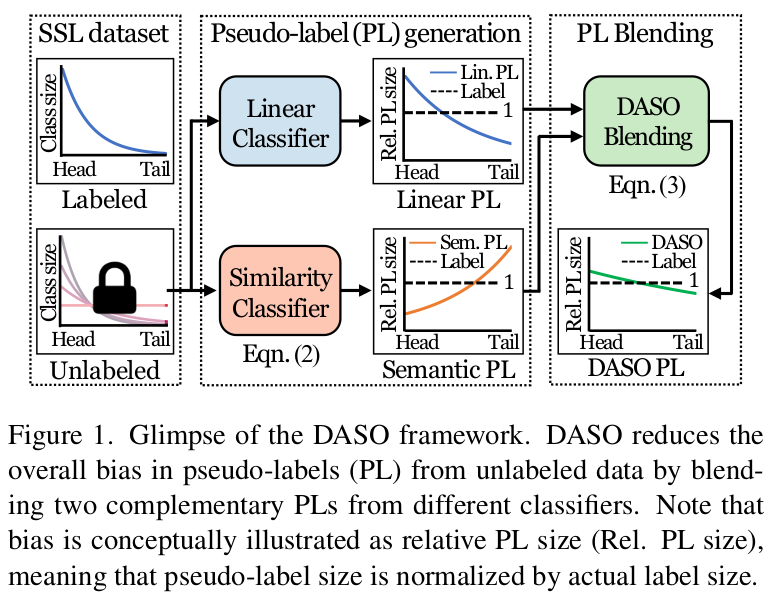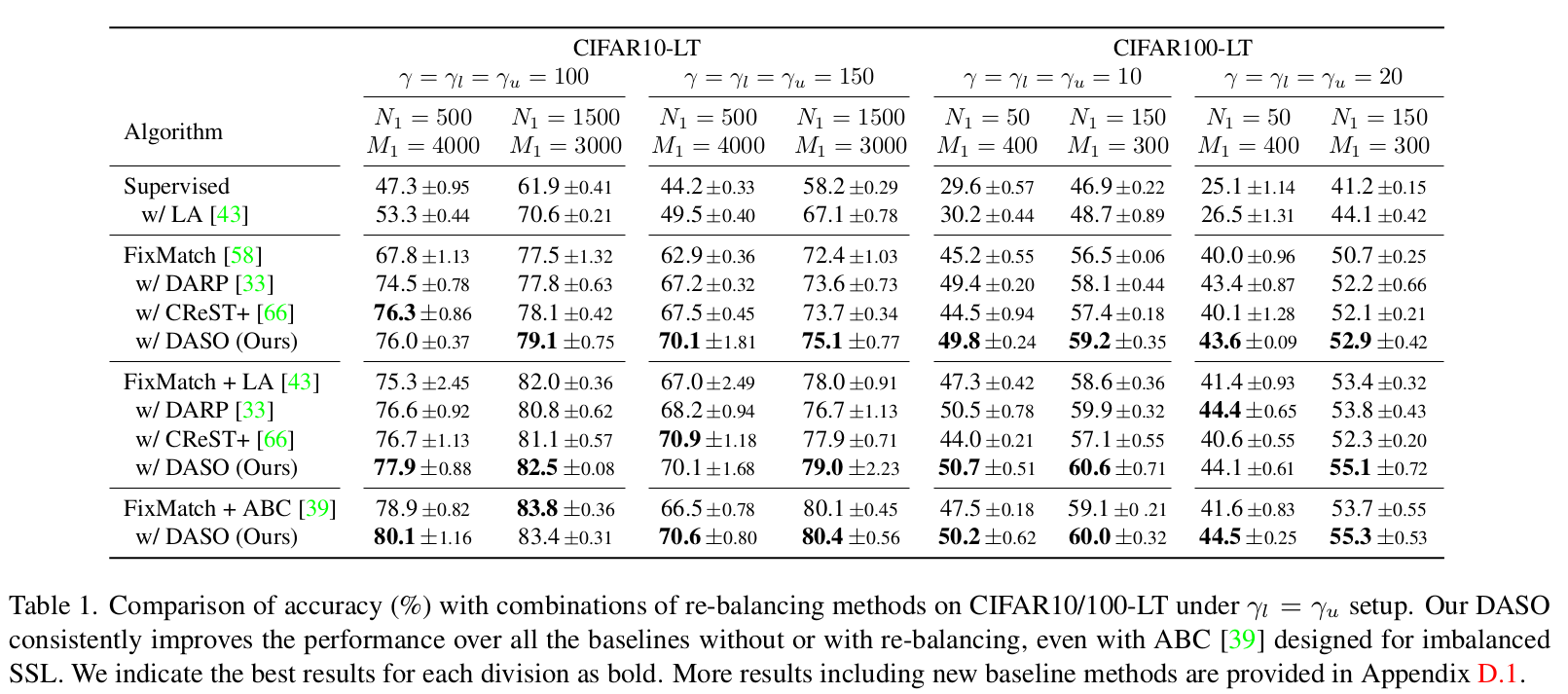[SSL][CI][CLS] Distribution-Aware Semantics-Oriented Pseudo-label for Imbalance Semi-Supervised Learning
DASO: Distribution-Aware Semantics-Oriented Pseudo-label for Imbalance Semi-Supervised Learning
- paper: https://arxiv.org/pdf/2106.05682.pdf
- github: https://github.com/ytaek-oh/daso
- downstream task : Class-Imbalance SSL for Classification
1. Motivation
- 기존에 연구되는 semi-supervised learning은 label과 unlabel의 class 분포가 같다고 가정한다. 이는 매우 현실과 괴리된 가정이다.
- Class imbalanced semi-supervised learning을 고려해야 한다.
- Similarity-based classifier와 Linear classifier의 분포 bias가 서로 상이하여 보완이 될 수있는 점을 발견!

- Similarity classifer : Class prototype과의 유사도 (cosine-similiarity)를 기준으로 class probability score를 산출하는 분류기
2. Contribution
- Class Imbalanced data에서 semi-supervised learning 시에, labeled data & unlabeled data간의 distribution이 같다는 approximation을 제거하고 bias를 완화하는 SSL 방법 (DASO) 제안
- Similarity classifier는 minor class로 distribution이 bias되는 현상 포착
- Linear classifer는 major class로 distribution이 bias되는 현상 포착
- 둘의 조합으로 pseudo label을 class-wise하게 rebalancing하는 DASO 제안
- Similar prototype의 서로 다른 augmentation을 가한 consistency regularization loss를 추가함
- CIFAR-10/100, STL-10 등 Class-Imbalanced SSL (CI-SSL)에서 좋은 성능
- open-set class가 많은 long-tailead dataset Semi-Aves에서도 좋은 성능
3. DASO Psuedo framework
3.1 Imbalanced semi-supervised learning
defined as $\gamma_l=\frac{max_kN_k}{min_kN_k} » 1$ for labeled data, $\gamma_u=\frac{max_kM_k}{min_kM_k} » 1$
- $N_k$: labeled examples
- $M_k$: unlabeled examples
3.2 Motivation
- Linear Classfier 기법인 FixMatch, Similarity classifier 기법인 USADTM의 precision / recall을 major / minor class별 비교

- C0~C2 : Major class
- C7~C9: Minor class
- FixMatch는 Major class recall이 좋지만, minor class의 recall이 낮음
- USADTM은 minor class recall이 좋지만, (상대적으로) major class recall이 낮음
- 우리 방식 DASO는 모두 좋음
3.3 DASO Pseudo-label framework
1. Linear Classifier
\(\hat{p}=\sigma(f_{\phi}^{cls}(z^{(w)}))\) where $z^{(w)}=f_{\theta}^{enc}(A_w(u))$
- $\sigma$: softmax activation
- $z^{(w)}$: wealkly augmented feature map
2. Similarity Classifier
- Balanced prototype Generation
- class frequency에 따른 Queue size를 저장하지 않고, Class-wise fixed length $L$ 의 Queue에 feature를 저장
- encoder를 EMA로 업데이트 ($f_{\theta}^{enc}$의 $\theta’=\rho\theta’+(1-\rho)\theta$)
$q=\sigma(sim(z, \mathbb{C}/T_{proto}))$
- $sim$ : similairty function (cosine similarity)
- $\mathbb{C}$: Class prototype
- $T_{proto}$: prototye temperature hyper-parameter
3. Distirbution-aware Blending
Major class에 biased된 linear classifier와 minor class에 biased된 similarity classifier의 출력의 interpolation으로 최종 pseudo label 생성
\(\hat{p}'=(1-v_k')\hat{p}+v_k'\hat{q}\) where 
- $\hat{m}$: $\hat{p}’$의 class-wise distribution 을 temporary 저장하여 normalized한 값
- 1,000개의 queue에 pseudo label $\hat{p}’$가 argmax로 class k에 할당되면 k class에 수를 증가. 최종 update는 1,000번에 한번 진행 (code 분석 결과)
- 즉, Major class에 속하는 class일수록 $v_k$는 1에 가까워 짐
- Most major class는 $\hat{q}$로, Most minor class는 $\hat{p}$로 업데이트 → Dibiased pseudo label
- 장점 : pre-defined distribution (가령, labeled distribution)이 요구되지 않음
4. Semantic-aware Loss
$L_{align}=H(\hat{q}, q^{(s)})$
- $H$ : Cross-entropy loss
-
$q^{(s)}$ : strong-augmented similarity probability score
- 가장 similar한 class prottype과의 similarity classifier output을 다른 augmentation을 먹인 분포 사이에 consistency regularization을 가한 loss → 더 뛰어난 feature를 추출 (SimCLR, MoCo, etc)
5. Overall Loss
$L_{DASO}=L_{cls}+\lambda_uL_u+\lambda_{align}L_{align}$
4. Experiment
-
Balanced SSL

-
Imbalanced SSL

-
Ablation Studies
